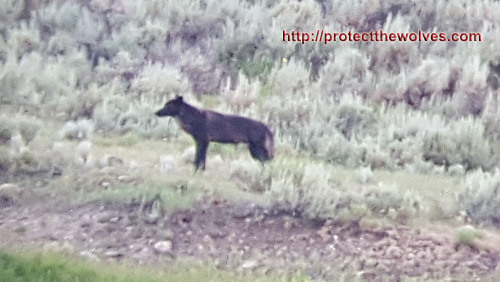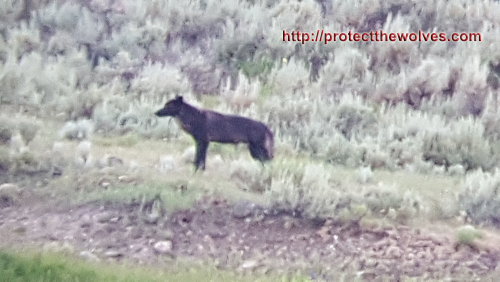
Uncollared Junction Butte Female going hunting Just before dark. The Vanguard 82A spotting scope made it look like daylight!
We were very lucky to be able View the Wolves in Yellowstone’s Junction Butte Pack because it appeared they had used an age old habit to select not only their Whelping Den, but also their Rendezvous Den, up until a recent Incident that happened at the Junction Butte Rendezvous Den site!
It was argued that amongst some Facebook experts, that are never even present in the Park that the pack was going to move the den…. Guess what, They had already done so and chose a site from old ingrained habits, These so called experts would also have you believe The JB’s were having a wonderous Carefree kickback summer with no calamities… which brought them no adverse stress or grief…. Those sites must somehow be breathing fairy dust, while living in a fantasy land where there are no problems, because the JB’S once safe home selection had been all but destroyed once again by humans.
It bothers me that there were sites that claimed they were not bothered!! It is quite obvious that they were bothered simply because they left their chosen spot!
The authors that did the study found general patterns in the breeding areas of wolves. keeping in mind the hunting history by men in North America, the scientific team states that in Europe and Asia wolves are sensitive to humans when selecting the areas where to take care of their babies and they usually go for the highest and abrupt areas in their territories. However, in North America, this sensitiveness is not the same and wolves use to choose valleys and softer relief areas, as we witnessed in Slough Creek in Yellowstone National Park where the Junction Butte Pack had chosen a Den site in a way they used to do before human disturbance. Will the Junction Butte Pack choose a Similar site in the future for raising their pups? The answer would be highly unlikely due to the fear of once again having their home violated by humans. The Junction Butte Pack was at peace, where they chose to raise their young from genetically ingrained habits where they could view whatever threats were approaching them, the pups had water very close that allowed them to go to without direct supervision, they were centered directly in the middle of their hunting area… that made is easier for them to return to feed the pups from a distance equal from either side of their hunting grounds.
Stay Tuned, More to come on the Violation of the Junction Butte Rendezvous site!
Below you will see the article that lends credibility to our already reported opinion.
Wolves lower the risk of interacting with humans during the reproduction period -when they are most vulnerable- and adopt some similar behaviors in their areas, from Alaska to India and Afghanistan, according to a new study published in the journal Biological Conservation, which has as its first author Víctor Sazatornil, collaborator at the Department of Evolutionary Biology, Ecology and Environmental Sciences of the University of Barcelona.
The wolf (Canis lupus) covers a wide area on Earth compared to most of terrestrial mammals. This fact, together with the ancestral conflict with the man and their survival capacity, makes the wolf to be considered one of the most capable animals to prosper in any kind of environment, including the human-dominated ones.
This perception is not wrong, but the wolf’s vulnerability towards men reaches a high point at some moments of its life cycle (reproduction period, etc.) according to the article by this team made up by 27 researchers from 12 countries, published in the journal Biological Conservation.
According to Víctor Sazatornil (UB), “after revising 728 breeding places from different wolf areas, we found that, in general, wolves lower the risk of interaction with humans by placing their breeding areas in places far from human activity territories, or placing them in areas with more refuge, unseen or with difficult access for the man. This behaviour seems to be more present where there is more human presence.”
When the wolf seeks refuge for the baby
The authors found general patterns in the breeding areas of wolves. Having in mind the hunting history by men in Eurasia and North America, the scientific team states that in Europe and Asia wolves are sensitive to humans when selecting the areas where to take care of their babies and they usually go for the highest and abrupt areas in their territories. However, in North America, this sensitiveness is not the same and wolves use to choose valleys and softer relief areas.
“In Eurasia there is a narrower co-existence between wolves and human activity. Therefore, by sticking in more humanized areas, they are more careful with the breeding areas to maintain the balance with the higher exposure to humans” says Víctor Sazatornil, who is working on his doctoral thesis under the supervision of José Vicente López-Bao (University of Oviedo) and Alejandro Rodríguez (Doñana Biological Station, EBD-CSIC) and tutored by Professor Santiago Mañosa (Department of Evolutionary Biology, Ecology and Environmental Sciences and the Biodiversity Research Institute (IRBio).
According to the expert José Vicente López-Bao, “one of the hypotheses we consider is that the different persecution history done in both continents can be a reason to explain the seen patterns. In Eurasia, persecution started with the appearance of farming and it got stronger gradually, while in North America they ended with the wolves in big areas some decades after colonization and with efficient means from the very first moment.”
During North America’s colonization, they had efficient means -fire guns, poison, etc.- to go after big mammals. For instance, the American bison population went from millions before the Europeans’ arrival to a few hundred in the late 19th century. Regarding the wolf’s case, a period of exposure to persecution different between continents could have influenced in the adaptation of the species protection in Eurasia, where the adaptation process was more gradual.
Surviving in the most humanized environments
According to the authors, the management of the habitat for wolves goes unnoticed in humanized environments -for instance, the Iberian peninsula- because they probably assume that it doesn’t affect much to the species, which has survived until now in this environment. We should at least guarantee the presence of small areas inside those territories where there is preservation of plants offering protection and human activity is controlled during the breeding period.”
Story Source:
The above post is reprinted from materials provided by Universidad de Barcelona. Note: Materials may be edited for content and length.
Journal Reference:
- Víctor Sazatornil, Alejandro Rodríguez, Michael Klaczek, Mohsen Ahmadi, Francisco Álvares, Stephen Arthur, Juan Carlos Blanco, Bridget L. Borg, Dean Cluff, Yolanda Cortés, Emilio J. García, Eli Geffen, Bilal Habib, Yorgos Iliopoulos, Mohammad Kaboli, Miha Krofel, Luis Llaneza, Francesca Marucco, John K. Oakleaf, David K. Person, Hubert Potočnik, Nina Ražen, Helena Rio-Maior, Håkan Sand, David Unger, Petter Wabakken, José Vicente López-Bao. The role of human-related risk in breeding site selection by wolves. Biological Conservation, 2016; 201: 103 DOI: 10.1016/j.biocon.2016.06.022
Source: Wolves seeks refuge from hunters during breeding periods — ScienceDaily

Comments
every day and in every way..please save the wolves….thank you…